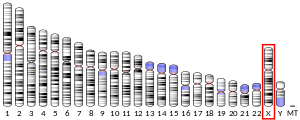PHEX
Phosphate-regulating neutral endopeptidase, X-linked also known as phosphate-regulating gene with homologies to endopeptidases on the X chromosome or metalloendopeptidase homolog PEX is an enzyme that in humans is encoded by the PHEX gene.[5][6] This gene contains 18 exons and is located on the X chromosome.
Function
The protein encoded by this gene is a transmembrane endopeptidase that belongs to the type II integral membrane zinc-dependent endopeptidase family. The protein is thought to be involved in bone and dentin mineralization and renal phosphate reabsorption.[7] The bone and dentin protein osteopontin (OPN) which inhibits mineralization in the skeleton and in teeth is a substrate for PHEX.[8] In the absence of functional PHEX in the mouse model (Hyp) of X-linked hypophosphatemia (XLH), and in human XLH where PHEX activity is decreased or absent, in addition to renal phosphate wasting, osteopontin and osteopontin fragments accumulate in bone and teeth and may contribute locally to the osteomalacia characteristic of XLH/HYP.[9][10][11][12][13] XLH patients have soft and deformed skeletons and soft teeth that easily become infected.
Clinical significance
Mutation of PHEX leads to X-linked hypophosphatemia.[5]
References
- GRCh38: Ensembl release 89: ENSG00000102174 - Ensembl, May 2017
- GRCm38: Ensembl release 89: ENSMUSG00000057457 - Ensembl, May 2017
- "Human PubMed Reference:". National Center for Biotechnology Information, U.S. National Library of Medicine.
- "Mouse PubMed Reference:". National Center for Biotechnology Information, U.S. National Library of Medicine.
- Francis, F. (October 1995). "A gene (PEX) with homologies to endopeptidases is mutated in patients with X-linked hypophosphatemic rickets (XLH/HYP). The HYP Consortium". Nat. Genet. 11 (2): 130–6. doi:10.1038/ng1095-130. PMID 7550339. S2CID 6424732.
- Grieff M, Mumm S, Waeltz P, Mazzarella R, Whyte MP, Thakker RV, Schlessinger D (February 1997). "Expression and cloning of the human X-linked hypophosphatemia gene cDNA". Biochem. Biophys. Res. Commun. 231 (3): 635–9. doi:10.1006/bbrc.1997.6153. PMID 9070861.
- "Entrez Gene: phosphate regulating endopeptidase homolog".
- Barros, NMT; et al. (2013). "Proteolytic processing of osteopontin by PHEX and accumulation of osteopontin fragments in Hyp mouse bone, the murine model of X-linked hypophosphatemia". Journal of Bone and Mineral Research. 28 (3): 688–699. doi:10.1002/jbmr.1766. PMID 22991293.
- Boukpessi, T; Gaucher, C; Léger, T; Salmon, B; Le Faouder, J; Willig, C; Rowe, PS; Garabédian, M; Meilhac, O; Chaussain, C (August 2010). "Abnormal presence of the matrix extracellular phosphoglycoprotein-derived acidic serine- and aspartate-rich motif peptide in human hypophosphatemic dentin". The American Journal of Pathology. 177 (2): 803–12. doi:10.2353/ajpath.2010.091231. PMC 2913338. PMID 20581062.
- Boukpessi, T; Hoac, B; Coyac, BR; Leger, T; Garcia, C; Wicart, P; Whyte, MP; Glorieux, FH; Linglart, A; Chaussain, C; McKee, MD (21 November 2016). "Osteopontin and the dento-osseous pathobiology of X-linked hypophosphatemia". Bone. 95: 151–161. doi:10.1016/j.bone.2016.11.019. PMID 27884786.
- Barros, NM; Hoac, B; Neves, RL; Addison, WN; Assis, DM; Murshed, M; Carmona, AK; McKee, MD (March 2013). "Proteolytic processing of osteopontin by PHEX and accumulation of osteopontin fragments in Hyp mouse bone, the murine model of X-linked hypophosphatemia". Journal of Bone and Mineral Research. 28 (3): 688–99. doi:10.1002/jbmr.1766. PMID 22991293.
- McKee, MD; Hoac, B; Addison, WN; Barros, NM; Millán, JL; Chaussain, C (October 2013). "Extracellular matrix mineralization in periodontal tissues: Noncollagenous matrix proteins, enzymes, and relationship to hypophosphatasia and X-linked hypophosphatemia". Periodontology 2000. 63 (1): 102–22. doi:10.1111/prd.12029. PMC 3766584. PMID 23931057.
- Salmon, B; Bardet, C; Coyac, BR; Baroukh, B; Naji, J; Rowe, PS; Opsahl Vital, S; Linglart, A; Mckee, MD; Chaussain, C (August 2014). "Abnormal osteopontin and matrix extracellular phosphoglycoprotein localization, and odontoblast differentiation, in X-linked hypophosphatemic teeth". Connective Tissue Research. 55 Suppl 1: 79–82. doi:10.3109/03008207.2014.923864. PMID 25158186. S2CID 19702315.
This article incorporates text from the United States National Library of Medicine, which is in the public domain.



